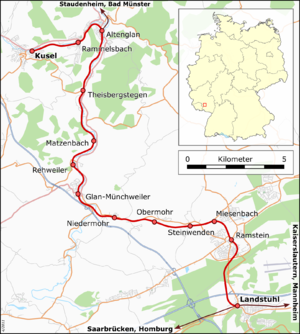Landstuhl–Kusel railway
| Landstuhl–Kusel | ||||||||||||||||||||||||||||||||||||||||||||||||||||||||||||||||||||||||||||||||||||||||||||||||||||||||||||||||||||||||||||||||||||||||||||||||||||||||||||||||||||||||||||||||||||||||||||
|---|---|---|---|---|---|---|---|---|---|---|---|---|---|---|---|---|---|---|---|---|---|---|---|---|---|---|---|---|---|---|---|---|---|---|---|---|---|---|---|---|---|---|---|---|---|---|---|---|---|---|---|---|---|---|---|---|---|---|---|---|---|---|---|---|---|---|---|---|---|---|---|---|---|---|---|---|---|---|---|---|---|---|---|---|---|---|---|---|---|---|---|---|---|---|---|---|---|---|---|---|---|---|---|---|---|---|---|---|---|---|---|---|---|---|---|---|---|---|---|---|---|---|---|---|---|---|---|---|---|---|---|---|---|---|---|---|---|---|---|---|---|---|---|---|---|---|---|---|---|---|---|---|---|---|---|---|---|---|---|---|---|---|---|---|---|---|---|---|---|---|---|---|---|---|---|---|---|---|---|---|---|---|---|---|---|---|---|---|
 |
||||||||||||||||||||||||||||||||||||||||||||||||||||||||||||||||||||||||||||||||||||||||||||||||||||||||||||||||||||||||||||||||||||||||||||||||||||||||||||||||||||||||||||||||||||||||||||
| Overview | ||||||||||||||||||||||||||||||||||||||||||||||||||||||||||||||||||||||||||||||||||||||||||||||||||||||||||||||||||||||||||||||||||||||||||||||||||||||||||||||||||||||||||||||||||||||||||||
| Locale | Rhineland-Palatinate, Germany | |||||||||||||||||||||||||||||||||||||||||||||||||||||||||||||||||||||||||||||||||||||||||||||||||||||||||||||||||||||||||||||||||||||||||||||||||||||||||||||||||||||||||||||||||||||||||||
| Line number |
|
|||||||||||||||||||||||||||||||||||||||||||||||||||||||||||||||||||||||||||||||||||||||||||||||||||||||||||||||||||||||||||||||||||||||||||||||||||||||||||||||||||||||||||||||||||||||||||
| Technical | ||||||||||||||||||||||||||||||||||||||||||||||||||||||||||||||||||||||||||||||||||||||||||||||||||||||||||||||||||||||||||||||||||||||||||||||||||||||||||||||||||||||||||||||||||||||||||||
| Line length | 28.7 km (17.8 mi) | |||||||||||||||||||||||||||||||||||||||||||||||||||||||||||||||||||||||||||||||||||||||||||||||||||||||||||||||||||||||||||||||||||||||||||||||||||||||||||||||||||||||||||||||||||||||||||
| Track gauge | 1,435 mm (4 ft 8 1⁄2 in) standard gauge | |||||||||||||||||||||||||||||||||||||||||||||||||||||||||||||||||||||||||||||||||||||||||||||||||||||||||||||||||||||||||||||||||||||||||||||||||||||||||||||||||||||||||||||||||||||||||||
| Route number | 671 | |||||||||||||||||||||||||||||||||||||||||||||||||||||||||||||||||||||||||||||||||||||||||||||||||||||||||||||||||||||||||||||||||||||||||||||||||||||||||||||||||||||||||||||||||||||||||||
|
||||||||||||||||||||||||||||||||||||||||||||||||||||||||||||||||||||||||||||||||||||||||||||||||||||||||||||||||||||||||||||||||||||||||||||||||||||||||||||||||||||||||||||||||||||||||||||
The Landstuhl–Kusel railway is a branch line in the German state of Rhineland-Palatinate, connecting the town of Kusel to the railway network. It was the first line built by the Palatine Northern Railway Company (Gesellschaft der Pfälzischen Nordbahnen), which was then responsible within the Palatinate for all railway lines to the north of the Mannheim–Saarbrücken railway (Palatine Ludwig Railway) between Ludwigshafen and Bexbach and the first in the North Palatine Uplands. It was also the only railway in the western part of these uplands that was not threatened with closure at any time. The main purpose of its establishment was the development of the quarries in the area of the Altenglan area, leading to it being sometimes called the Steinbahn (German for "stone railway").
From 1904, the Glan-Münchweiler–Altenglan section was also part of the Glan Valley Railway (Glantalbahn), which was built for strategic reasons, but closed for passenger services between 1961 and 1986. In 1936, an extension to Türkismühle was opened for military reasons, but it was closed down in stages between 1964 and 1970. The route is operated by DB Regio using class 643 (Bombardier Talent) diesel multiple units at hourly services with additional services in the peak hour.
In the early 1860s, the towns of Ramstein and Kusel, which at the time were part of the Kingdom of Bavaria, formed committees to promote the construction of a railway. According to a memorandum published in Kusel in 1861, the railway would branch from the Palatine Ludwig Railway in Landstuhl and run through the Mohrbach, Glan and Kuselbach valleys to Kusel. In the memorandum, it was argued that, among other things, the railway construction would improve the rather poor economic and social conditions of the region. The construction of the proposed Landstuhl–Kusel line under a concession issued in 1866 was funded by an issue of shares for a total of 1,740,000 guilders. The company also was given a government guarantee on its interest.
...
Wikipedia
